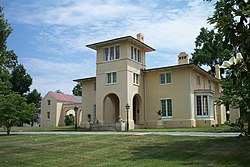Blandwood Mansion and Gardens
|
Blandwood
|
|

A. J. Davis designed Tuscan Villa
|
|
| Location | 447 W. Washington St., Greensboro, NC |
|---|---|
| Built | 1795, additions 1822 and 1844 |
| Architect | Alexander Jackson Davis |
| Architectural style | Italianate |
| NRHP Reference # | 70000455 |
| Significant dates | |
| Added to NRHP | April 17, 1970 |
| Designated NHL | June 7, 1988 |
Blandwood Mansion is a historic house museum at 447 West Washington Street in Greensboro, North Carolina. Originally built as a four room Federal style farmhouse in 1795, it was home to two-term North Carolina governor John Motley Morehead (1841-1844) under whose ownership it was transformed into its present appearance. It is believed to be the oldest extant example of the Italian Villa Style of architecture in the United States, and was designated a National Historic Landmark in 1988. In creating the design for Blandwood, architect Alexander Jackson Davis produced a popular prototype for American house designs in the Italianate style: a central tower projecting from the main facade. Saved from demolition in 1964 by preservation-minded Greensboro citizens, the house was opened as a museum in 1976 and remains open to the public today.
Initially constructed as a two-story, four-room frame farmhouse in 1795, Blandwood likely took the name of its first occupant and builder, Charles Bland. Bland and his wife Catherine farmed the surrounding 100 acres until 1800, when the property was sold to Joseph Thornburg for his son Joseph Thornburg, Jr. The property was purchased by industrialist Henry Humphries in 1822 for $50. Humphries founded the Mt. Hecla Cotton Mill in 1818, which was reconstituted in 1826 as the first steam-powered cotton mill in North Carolina.
Governor Morehead lived in the house from 1827 until his death in 1866. As a political leader, Morehead hosted numerous intellectuals of the day including social activist Dorothea Dix and architect Alexander Jackson Davis. During the Civil War, the house served as quarters for Confederate General P. G. T. Beauregard, and after the fall of the Confederacy the house was temporary headquarters for Union Generals Jacob Dolson Cox and John Schofield. North Carolina Governor Zebulon B. Vance surrendered himself to Cox and Schofield in the main parlor of Blandwood on May 2, 1865.
Blandwood had two additions. The first in 1822 expanded the frame farmhouse from four to six rooms and continued the Federal architecture period details of the initial house. The second addition was extensive and designed in 1844 by New York City architect Alexander Jackson Davis. This addition more than doubled the square footage of the house within a "Tuscan Villa" style wing. The Davis addition makes Blandwood the oldest standing example of Tuscan Villa (a subtype of Italianate architecture) in the United States. Construction of the masonry expansion was executed by William and Joseph Conrad, building contractors from nearby Lexington, North Carolina The grounds of Blandwood were influenced by landscape architect Andrew Jackson Downing, who used an illustration of Blandwood in his publications to depict appropriate landscaping.
...
Wikipedia
